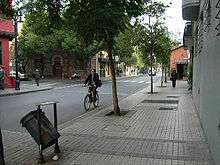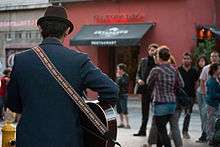Barrio Lastarria


Barrio Lastarria (Lastarria Neighborhood) is an historical neighborhood in the center of Santiago, Chile. Now a popular tourist hub, Barrio Lastarria is a center for cultural activity, with cinemas, theaters, museums, restaurants and bars. Activities such as festivals and live performances are commonly held throughout the streets of Lastarria given its strong cultural flavor, particularly in J.V. Lastarria street and Parque Forestal.[1]
Barrio Lastarria is bordered by the Alameda and Centro Cultural Gabriela Mistral to the south, Santa Lucía Hill to the west, Parque Forestal to the north and Plaza Baquedano to the east. Metro stations Universidad Católica and Bellas Artes provide direct access.
History
Following the Conquest of Chile by Pedro de Valdivia, this area was left under the control of Bartolomé Blumenthal, a German migrant to Chile, who built a mill on the site.[2] As with many neighborhoods in Santiago’s center, Barrio Lastarria was built around a church: in this case, the Iglesia de la Veracruz. Houses were built between the winding streets, notably the house at Plaza Mulato Gil de Castro, built in the beginning of the 19th century. Despite the neighborhood’s early origins, the plaza was only built in 1981 due to interest in preserving a series of facades beginning at the historic house of Gil de Castro.[3]
During the 1990s, the neighborhood began a process of restoration with care not to alter its bohemian and intellectual flavor, with a number of cafés, bars and cultural centers appearing towards the end of the decade and the restoration of facades of the Iglesia de la Veracruz in 2001 and 2002.[4] Since then, as an historic area in Santiago, it has been able to maintain its traditional character despite new development. Barrio Lastarria was declared an official Zona Típica by Chile in 1997.[5]
Places of Interest
- Cafés, cinemas and museums in J.V. Lastarria street.
- Plaza Mulato Gil de Castro.
- Cafés, theaters and cultural centers in Monjitas and Merced streets, including Teatro Ictus and Teatro Lastarria 90.
- Bars, cafés and florists in the area of José Miguel de la Barra-Victoria Subercaseaux, including Mosqueto street.
- Area between Parque Forestal and Chilean National Museum of Fine Arts.
- Santa Lucía Hill.
- Palacio Bruna and Iglesia de la Veracruz.
- Hotels and hostels on the streets Victoria Subercaseaux and Rosal.
- The Centro Cultural Gabriela Mistral, the first building which can be seen when entering Barrio Lastarria from the Alameda, opened in 2010.[6]
See also
References
- ↑ See, for example, Chile art competition begins in Parque Forestal. Santiago Times. 8 November 2012. Retrieved 28 November 2012.
- ↑ La cultura urbana y los estilos de vida en la revitalizacion de un barrio patrimonial del centro histórico de Santiago. El caso Lastarria-Bellas Artes. Doctorate thesis, Christian Matus Madrid, Pontificia Universidad Católica de Chile. Faculty of Architectural Design and Urban Studies. 2010. p.123.
- ↑ La cultura urbana y los estilos de vida en la revitalizacion de un barrio patrimonial del centro histórico de Santiago. El caso Lastarria-Bellas Artes. Doctorate thesis, Christian Matus Madrid, Pontificia Universidad Católica de Chile. Faculty of Architectural Design and Urban Studies. 2010. p.160.
- ↑ Acerca del Barrio Lastarria. Barriolastarria.com. Retrieved 28 November 2012.
- ↑ "What to do in the Barrio Lastarria". This is Chile. 30 December 2009. Retrieved 12 November 2012.
- ↑ Inauguration of the Centro Cultural Gabriela Mistral Illuminates Santiago. This is Chile. 7 September 2012. Retrieved 28 November 2012.
External links
- Barrio Lastarria Tourist and Cultural Information Portal (Spanish)
- The Singular Santiago, Lastarria Hotel
Template:Barrio Lastarria
Coordinates: 33°26′18″S 70°38′25″W / 33.43833°S 70.64028°W